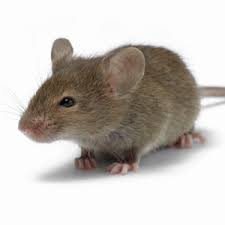Mice
 Common Name: House mouse
Common Name: House mouse
Scientific Name: Mus domesticus
Introduction: The house mouse is believed to have arrived in Britain in 10 century BC. It gradually spread throughout the country and now has become worldwide distribution through agricultural practices and trading. However the house mouse maybe confused with the other three species found in Britain which are: the wood mouse, the yellow neck field mouse and the harvest mouse. Three of these mice species live outdoors in places such as: fields, garages, sheds, and outhouses, but sometimes can enter houses, while the house mouse live indoors. It is the most commonly encountered commensal rodent and is more than a nuisance. They damage personal property by gnawing, eating and contaminating stored food; they are disease carriers and therefore, put human health at risk.
Recognition: The adult house mouse is approximately 70-90mm long, head and body combined and weighs about 15-25 grams. It has smooth fur and the colour is usually dust-grey or brownish, and a light grey on the belly. The house mouse has a pointed snout, small eyes, upper notched incisors, which differentiate them from British small mammals.
Signs of Infestation: Sighting, Scratching, gnawing, burrows, smears or (black marks), nest, smell or ('stale' odour) fresh dead mouse, fresh and old droppings (fresh dropping usually dark, soft, moist and shiny) (older droppings are dull and hard).
Biology: The house mouse is a prolific breeder. They reach sexual maturity at 6 weeks old, (later under crowded or cold conditions) 8 -12 weeks. Gestation period lasts an average of 17-20 days. The young are born blind and hairless except for vibrissae, and weigh just one gram, the young ones are weaned at about 3 weeks old. The average litter size is 5-6 with an average of 8 litters per year. Under ideal conditions, the female house mouse can give birth every 25 days producing 5-10 litters each having 4-8 young. The average life expectancy is normally 10 months but those which live in close association with man can live for more than 2 years. The stability of their environment is the availability of food, water and harbourage. The movement of a house mouse is the presence of other mice, cats, and the availability of food and water. They like to familiarise themselves with their home range and use familiar pathways, living smears or (black marks) by continuous rubbing of their fur against the surfaces. They also live in demes, (family groups) which consist of one dominant male, 2-5 females and up to 3 subordinate males. The dominate male behaves aggressively to keep his group together from other males taking over. They are largely nocturnal mammals but still able to see movement within their line of sight. The house mouse communicate by chemicals or 'pheromones' excreted by special glands or in urine and this enables them to recognise whether or not they are from the same group, their status, sex, breeding conditions and individuality.
Potential harm: Because of the conditions provided by humans, the mouse can live in close association with man. These bring a range of serious problems. Diseases (zoonoses): including lymphocytic choriomeningitis salmonellosis (food poisoning) gastro-enteritis accompanied by headache and fever. Parasites include mites, ticks, tapeworm and fleas. Rodent consume and contaminate of human and animal food by their droppings, urine, fur and eating. They have very hard incisors that can penetrate concrete, lead, aluminium, and a range of other metals causing costly repairs and even fires when electrical supplies are damaged.
Food source: They consume very little water and their intake is regulated by the moisture content in their food. Once the moisture content is up to 15 -16%, a mouse will consume 3-4 grams of food a day. They will eat mostly all food consume by man. e.g. bread, flour, rice, wheat, chocolate, cakes, crisps, fruits, grains seeds, cereals, nuts and biscuits.
Control
Trapping : In the event of an infestation a large number of traps should be used in order to be effective and successful. Place traps at an angle in the area of the infestation. Suggested bait can be used in traps e.g. fruit, chocolate, peanut butter, bread, or cereal.
Rodenticides: Is the best and most effective way to deal with an infestation. There are two types of rodenticides which are first and second generation anti coagulant. Both can be used and it's up to the professional to decide. When treating mice infestation using rodenticide, use lots of bait solutions as necessary, as mice are sporadic feeders (move from bait station to another). Poor application of baiting can lead to treatment failure. Once the application has been corrected and there is still no take from the bait station exterminators in London would consider whether the mice has another food source, bait resistance or bait shyness. Another method which can be used for mice control is Integrated Pest Management (IPM).




























